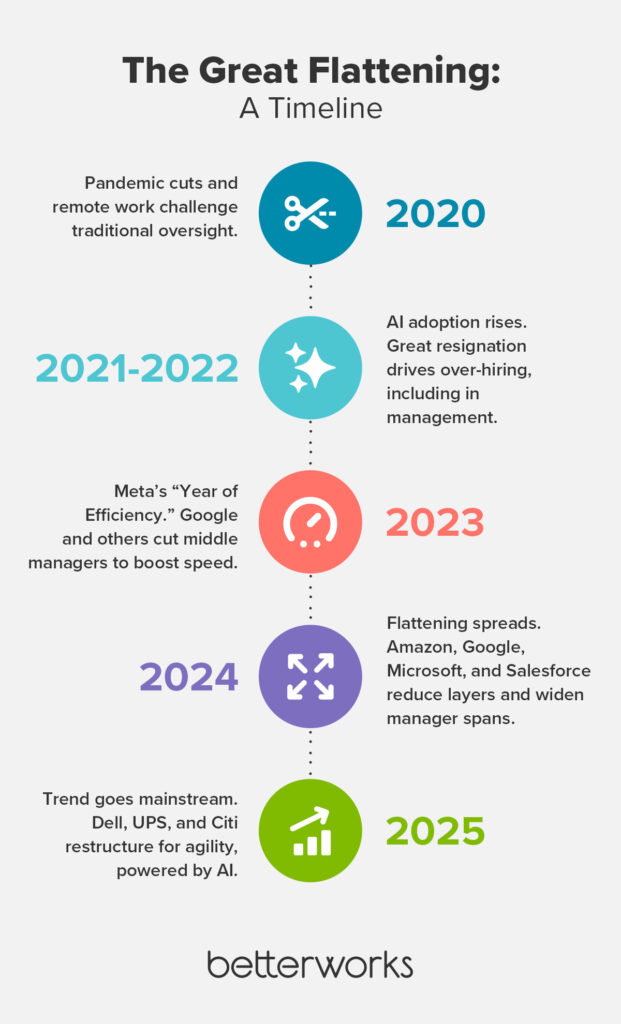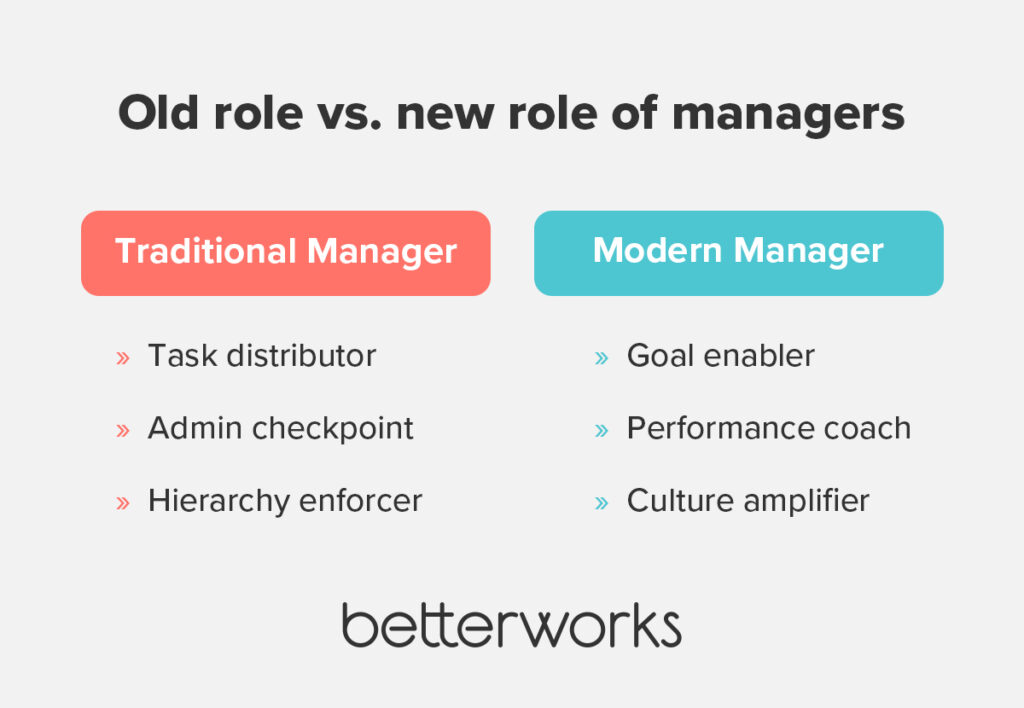- What is “The Great Flattening” and why is it happening now?
- What we lose when we cut the middle
- But flattening isn’t necessarily the problem
- 5 questions to ask before flattening your org
- Are your remaining managers equipped to lead larger, more complex teams?
- How will you maintain visibility into performance and progress?
- What will replace the coaching and context they once provided?
- Is employee development still supported or starting to drift?
- Can your performance conversations scale without middle layers?
- Don’t just flatten. Rethink your leadership model
- The great flattening: FAQs
Across industries, companies are cutting layers of management in pursuit of speed and efficiency. The movement — dubbed The Great Flattening — promises leaner teams and more empowered employees.
But the promise doesn’t always match the reality.
Korn Ferry’s 2025 Workforce Survey found that 41% of employees say their company has reduced management layers and 37% say that’s left them feeling directionless. When middle managers disappear, so can the structure, support, and alignment they provide. Strategies lose traction. Cultures get diluted. Feedback fades. And performance suffers.
Is less really more? Or are we removing the very people who hold teams together?
What is “The Great Flattening” and why is it happening now?
The Great Flattening describes a growing trend: companies removing layers of management to create leaner, faster-moving teams. It’s a shift taking hold across industries as organizations look to streamline decision-making and reduce overhead.
With tighter margins and rising labor costs, many companies are reevaluating the value of middle management. The return-to-office push has only intensified this focus. Leaders, under pressure to prove productivity gains, are doubling down on efficiency, and often see management layers as expendable. At the same time, automation and AI are handling more routine oversight, making it easier to justify flatter structures.
There’s also a cultural shift at play. Flat organizations are increasingly seen as modern and agile. For younger generations, especially Gen Z, traditional hierarchies feel outdated. Autonomy and transparency carry more weight than titles or reporting lines.
Executives in big tech have been vocal about expanding the span of control by removing unnecessary management roles. For example, Mark Zuckerberg has advocated for “managers managing managers” to either contribute directly or step aside. This push for efficiency is shaping how companies think about their organizational structure.
The intent is clear, but the impact is more complicated. Stripping away layers may increase speed, but it also removes the people who translate strategy into actionable execution, reinforce culture, and keep teams aligned. That’s why so many organizations exploring the great flattening quickly realize the real challenge: sustaining clarity and cohesion without middle management positions.

What we lose when we cut the middle
Managers are not overhead. They set the tone, connect the dots, and keep teams moving in the right direction. Without them, execution weakens and alignment starts to slip.
In many organizations, middle managers are already stretched thin. They’re expected to translate strategy, guide teams through ambiguity, and coach individuals — all while navigating a flood of competing demands. The role is increasingly defined by blurred expectations, rapid change, and complex communication. Without the right support, middle management starts to collapse under the weight. Nearly two-thirds of managers of people managers say they lack clarity about their roles, according to our 2024 State of Performance Enablement report.
In fact, overcoming middle manager burnout has become a critical challenge. When middle managers are overwhelmed by constant change, under-defined roles, and unrealistic demands, they can’t show up as the connectors, coaches, and carriers of culture they’re meant to be. Without targeted support and the right tools, this vital leadership layer becomes a weak link. Not by fault, but by design.
Over flattening leaves teams without the structure they need to perform. What’s removed in the name of speed often ends up costing more in lost momentum.
Strategy without structure
Executives can set bold visions, but that doesn’t mean teams know how to act on them. Middle managers help turn direction into execution, making goals feel tangible and achievable at every level.
Culture without carriers
Culture is kept alive in moments. In how tension is handled, how wins are celebrated, and how values show up in tough conversations. Without someone modeling and reinforcing those behaviors daily, culture can fade.
Feedback without frequency
Without regular coaching and check-ins, performance suffers. In overly flat organizations, feedback often becomes reactive or gets delayed until problems surface. Growth becomes harder to track, and course corrections come too late.
But flattening isn’t necessarily the problem
Flattening is only risky when it’s done without rethinking leadership and without a clear performance management strategy. Titles may change. Reporting lines may shrink. But teams still need guidance, feedback, and connection. Without it, performance drifts.
The structure is secondary. What matters is whether people are enabled to lead.
That’s where middle managers still play a critical role. They are crucial to aligning goals, developing talent, building strong cross-functional ties, and helping their teams adopt AI tools strategically. They provide the context, coaching, and connection that help teams navigate change and stay aligned. When that layer disappears, organizations often underestimate how much informal support and clarity go with it.
Removing managers without reworking how communication and support flow through the organization rarely succeeds. Senior leaders are often left trying to do too much, while team-level managers are stretched thin, unable to absorb the additional responsibilities.
If leaders agree that coaching, clarity, and support matter but still want to eliminate middle management, the key question becomes: Who will carry out those functions?
To succeed with flatter structures, organizations need to invest in this shift and equip remaining managers with the tools to lead differently. That includes not only redefining roles, but also reshaping communication, feedback loops, and support systems to match the new structure. A modern performance management strategy can fill the gaps left behind, ensuring alignment, growth, and connection stay intact even as hierarchy fades.

5 questions to ask before flattening your org
Flattening can create momentum or chaos. The difference comes down to what fills the gap once layers are removed. If teams lose clarity, support, or feedback, the structure won’t hold.
Before cutting management roles, ask whether your foundation is strong enough to function without them.
Are your remaining managers equipped to lead larger, more complex teams?
Fewer layers often mean broader spans of control. Managers who once had time to coach and develop their teams may now be stretched across functions, priorities, and geographies. Without proper support, even strong leaders can lose impact.
How will you maintain visibility into performance and progress?
Middle managers often serve as the eyes and ears of the organization. When they’re removed, signals can easily get lost. Clear, structured systems for tracking goals, surfacing blockers, and sharing updates become essential.
What will replace the coaching and context they once provided?
Removing a role doesn’t remove its value. If middle managers deliver support and real-time feedback, that function will still need to exist. Otherwise, teams are left to guess and fill in the gaps.
Is employee development still supported or starting to drift?
In flatter structures, growth can become less visible and less intentional. Without someone actively focused on learning and development, employees can feel stuck, even when the business is moving forward. That’s especially risky in a tight job market where retention depends on clear development paths.
Can your performance conversations scale without middle layers?
Feedback that was once embedded can become reactive or inconsistent. Are your tools and processes strong enough to keep performance aligned without the people who once drove it?
Flattening only works when it’s paired with intentional leadership. These questions help ensure you’re building a leaner org without weakening the core.
Don’t just flatten. Rethink your leadership model
The great flattening isn’t the issue. Failing to replace what gets lost is. Hierarchy may shrink, but teams still need clarity, coaching, and connection.
Flatter organizations require a new kind of leadership. One where middle managers shift from task-owners to performance enablers who clear paths, align on goals, and strengthen culture.
That shift takes intention, strong habits, and the right systems — like enterprise performance software — to support it.

Equip Managers to Build Connection, Drive Alignment, and Retain Talent
The right conversations make all the difference, especially in flatter, faster-moving organizations.
The great flattening: FAQs
The following questions reflect what many leaders are asking as they navigate the great flattening middle management challenge:
Is flattening sustainable?
Yes, but only if you replace what’s lost. Without systems for alignment and performance, many companies end up rebuilding layers informally.
How flat is too flat?
When managers oversee too many people or teams without support, development, and clarity break down. It’s not about titles. It’s about bandwidth.
How do employees grow in flat orgs?
Employees grow through feedback, coaching, and creative development paths like task rotation, cross-functional projects, and job shadowing. Growth just needs to be intentional.
Can tech replace middle managers?
No, but it can support them. The right tools reduce admin work so managers can focus on people, not processes.
What if flattening isn’t working?
You can still adapt. Revisit role clarity, reestablish decision rights, and reinforce support systems. Flat doesn’t mean leaderless — just different.


